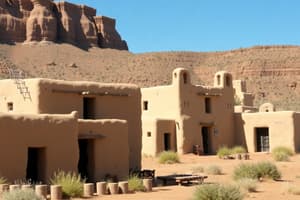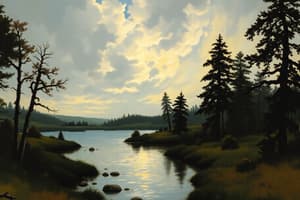Podcast
Questions and Answers
What happens to a person in the colony of Maryland who criticizes Jesus Christ or denies the existence of God?
What happens to a person in the colony of Maryland who criticizes Jesus Christ or denies the existence of God?
He will be put to death and his property will be confiscated by the Lords Proprietors of the Maryland colony.
Why would 'An Act Concerning Religion' be considered an important milestone in the history of religious tolerance in the Americas?
Why would 'An Act Concerning Religion' be considered an important milestone in the history of religious tolerance in the Americas?
While all citizens must avow a belief in God and Jesus Christ as his son and savior of the world, they are free to practice that Christian belief in their own way.
What implicit conclusion can be drawn from the Maryland Act Concerning Negroes Other Slaves (1664) regarding relationships between races?
What implicit conclusion can be drawn from the Maryland Act Concerning Negroes Other Slaves (1664) regarding relationships between races?
There were at least some white women who were married to black men in Maryland in 1664, something that was illegal 200 years later.
What view did Benjamin Franklin hold in 1751 regarding certain nationalities in the context of race?
What view did Benjamin Franklin hold in 1751 regarding certain nationalities in the context of race?
What did Benjamin Franklin state in 1751 about increasing the population of blacks in America?
What did Benjamin Franklin state in 1751 about increasing the population of blacks in America?
According to Table 3.1, where did the largest number of migrants to British North American colonies come from between 1700 and 1775?
According to Table 3.1, where did the largest number of migrants to British North American colonies come from between 1700 and 1775?
The painting, A Quaker Meeting, illustrates the prominent place of ____________ in Quaker gatherings.
The painting, A Quaker Meeting, illustrates the prominent place of ____________ in Quaker gatherings.
Why were Quakers considered unusual in their time?
Why were Quakers considered unusual in their time?
The separation of church and state was the norm, as most colonies had taxes to pay the salary of clergy.
The separation of church and state was the norm, as most colonies had taxes to pay the salary of clergy.
As English colonial society became more structured in the 18th century, what were the effects on women?
As English colonial society became more structured in the 18th century, what were the effects on women?
What was key to making the enslavement of Africans an enduring economic and social institution in colonial America?
What was key to making the enslavement of Africans an enduring economic and social institution in colonial America?
Who were the colonists that proved most dangerous and harmful to Native Americans?
Who were the colonists that proved most dangerous and harmful to Native Americans?
When did the first Americans arrive in the Americas?
When did the first Americans arrive in the Americas?
What larger group were the Indian tribes in California part of before Europeans arrived?
What larger group were the Indian tribes in California part of before Europeans arrived?
Who was Josephe, as mentioned in the Declaration of Josephe?
Who was Josephe, as mentioned in the Declaration of Josephe?
What was the chief focus question addressed in Chapter 1 regarding the Spanish Empire in America?
What was the chief focus question addressed in Chapter 1 regarding the Spanish Empire in America?
What does the Requerimiento of 1510 serve as a justification for?
What does the Requerimiento of 1510 serve as a justification for?
What statement best describes the purpose of Document 2?
What statement best describes the purpose of Document 2?
What role did religion play in the Spanish conquest of Latin America?
What role did religion play in the Spanish conquest of Latin America?
What is the historical significance of the description of the conquistadors' dogs?
What is the historical significance of the description of the conquistadors' dogs?
Which focus question from Chapter 1 would an analysis of Document 2 help answer?
Which focus question from Chapter 1 would an analysis of Document 2 help answer?
What was the outcome of religious dissent in England during the first half of the seventeenth century?
What was the outcome of religious dissent in England during the first half of the seventeenth century?
How did the separation of church and state in Massachusetts during the seventeenth century differ from today's U.S. government?
How did the separation of church and state in Massachusetts during the seventeenth century differ from today's U.S. government?
What was the root issue at the heart of the English Civil War in the 1640s?
What was the root issue at the heart of the English Civil War in the 1640s?
What was a key difference between indentured servants from England and slaves from Africa?
What was a key difference between indentured servants from England and slaves from Africa?
What drastically altered the way of life for Native Americans along the Atlantic Coast?
What drastically altered the way of life for Native Americans along the Atlantic Coast?
How did Puritans view individual and personal freedom?
How did Puritans view individual and personal freedom?
What summarizes the difference between the Massachusetts Bay Colony and Rhode Island regarding religious lives?
What summarizes the difference between the Massachusetts Bay Colony and Rhode Island regarding religious lives?
Why did Maryland, founded as a safe haven for Catholics, have many Protestants by the 1640s?
Why did Maryland, founded as a safe haven for Catholics, have many Protestants by the 1640s?
Flashcards are hidden until you start studying
Study Notes
Chapter 1: Native Americans and European Encounter
- First Americans migrated from Asia through Alaska at least 15,000 years ago, spreading southward.
- California was primarily populated by non-horticultural rancherian Indian tribes before European arrival.
- The Declaration of Josephe concerns a Spanish-speaking American Indian from present-day New Mexico.
- Image of "The Marriage of Captain Martin de Loyola to Beatriz Nusta" illustrates features of the Spanish Empire in America.
- The Requerimiento of 1510 served as legal and religious justification for Spain's territorial claims, urging natives to accept Spanish rule or face violence.
Document 2: Native Perspectives and Conquest
- "Motecuhzoma Awaits Word from the Messengers" captures the deep anxiety of an Aztec leader as Spanish forces approached.
- The description emphasizes the psychological impact of the Spanish on indigenous populations, showcasing unfamiliar technologies and practices.
- Document 2 highlights native experiences and understanding of the Spanish invasion, illustrating cultural clashes.
- Spanish religious motives were driven by a belief in the obligation to share Christianity with indigenous peoples.
Chapter 2: Religious and Political Tensions in England and the Colonies
- Religious dissent in seventeenth-century England led to the English Civil War, focused on who controlled government decisions.
- Massachusetts’ separation of church and state differed greatly from contemporary U.S. standards, reflecting the era's stringent religious influences.
- Understanding the historical significance of indentured servitude reveals differences with African slavery; servitude did not grant automatic belonging to an owner.
- Disease and environmental changes significantly disrupted the lives of Native Americans along the Atlantic Coast.
- Puritans viewed individual freedoms as a threat to the community's social harmony.
Comparative Colonial Governments
- Massachusetts aimed for religious uniformity to form a godly society, contrasting with Rhode Island's emphasis on religious freedom and individual conscience.
- The Maryland Toleration Act of 1649 illustrated attempts to establish religious order while allowing for some degree of tolerance among diverse Protestant groups.### Punishments for Offending the Sabbath
- Penalties imposed for profaning the Sabbath include imprisonment for first and second offenses.
- Offenders must publicly acknowledge their wrongdoing in court.
- A third offense results in public whipping.
Religious Tolerance in Maryland
- The law promotes peaceful governance and mutual love among inhabitants.
- Individuals professing belief in Jesus Christ are protected from persecution for their religion.
- No one can be compelled to practice a religion against their will, as long as they comply with governance.
Consequences of Disturbing Religious Freedom
- Offenders who disturb or molest believers face triple damages and a monetary fine.
- Monetary penalties include a forfeiture of 20s sterling, split between the Lord Proprietary and the aggrieved party.
- If unpaid, offenders can face imprisonment or public whipping.
Legal Enforcement Mechanisms
- Sheriffs are authorized to seize and sell goods of offenders to satisfy fines or penalties.
- Offenders can reclaim remaining goods after the satisfaction of imposed fines.
Historical Context of Religious and Social Norms
- The colony sought to attract skilled laborers, primarily from the Protestant labor class.
- Criticism of Jesus Christ or denial of God leads to severe penalties, including death and property confiscation.
Milestones in Religious Tolerance
- "An Act Concerning Religion" is considered significant for religious tolerance, allowing Christians to exercise their faith freely within specified bounds.
Social Dynamics and Race
- The Maryland Act concerning slaves indicates some interracial marriages existed, which became illegal over time.
- Benjamin Franklin expressed exclusionary views concerning the population in America, particularly around race and ethnicity.
Migration Trends
- The table indicates a notable influx of migrants from Africa to British North American colonies between 1700 and 1775.
Role of Women in Society
- Quaker meetings prominently featured women, showcasing their influence in religious gatherings.
- As society structured in the 18th century, women's roles became more defined and closely tied to domestic responsibilities.
Perpetual Slavery in America
- The enslavement of Africans evolved into a perpetual institution, with children of slaves also becoming enslaved, distinguishing it from other forms of servitude globally.
Impact of Farming on Native Americans
- Farmers posed the greatest danger to Native Americans, leading to significant disruption and harm to indigenous communities.
Studying That Suits You
Use AI to generate personalized quizzes and flashcards to suit your learning preferences.




